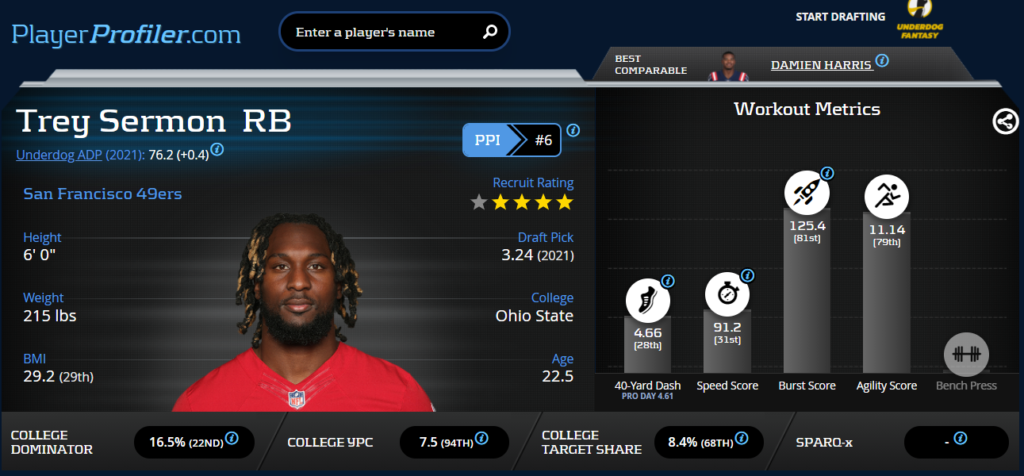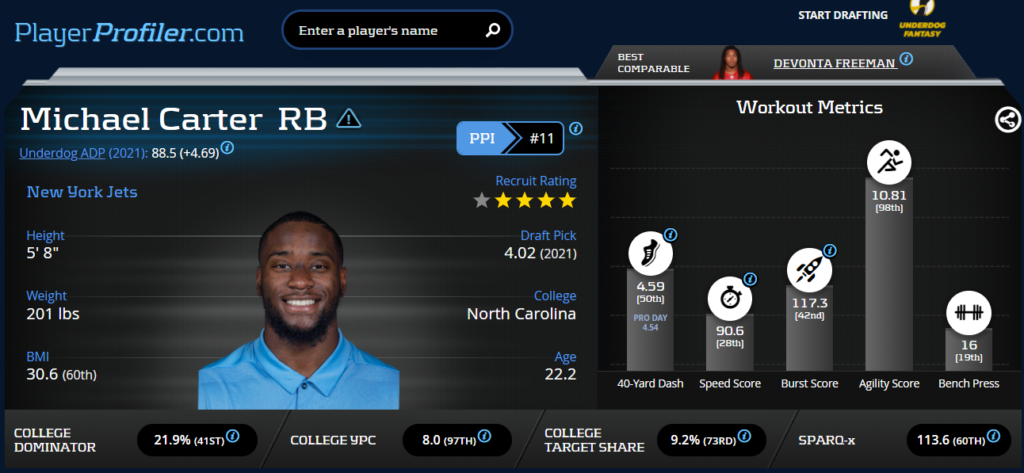The following contrived dichotomy (scheduled for one fall?) is to determine which of these two players we should be drafting to our fantasy football redraft teams, all else being equal.
Introducing first, in the RED CORNER: hailing from the San Francisco 49ers, standing 6-0, and weighing in at 215-pounds: “THE MINISTER“ TREY SERMON.
His opponent, in the BLUE CORNER: hailing from the New York Jets, standing in at 5-8, and weighing in at 201-pounds: MICHAEL CARTER.
The Tale of the Tape
Trey Sermon and Michael Carter are being picked at similar ADPs in redraft leagues. If you have drafted a team recently, you may have contemplated which player to take. Usually, they are going within a round of each other. However, I have seen them go as little as a few picks away from each other as well.
Here are a couple of recent drafts I participated in:
In Underdog drafts, Sermon’s ADP is 72.6 and Carter’s is 84.4. This is where the widest disparity exists among platforms I have drafted in this season so far.
Regardless of which format or platform one drafts on, these two players are going in the No. 25 to No. 35 range for running backs.
So the question is: if I am on the clock looking for a running back and both players are available, who would I rather take in my redraft leagues? Alex Johnson wrote up a great summary on which to choose in dynasty, but what about redraft?
Trey Sermon
Coming out of the draft, there has been some excitement for Trey Sermon. He averaged 7.5 (94th-percentile among qualified running backs) Yards Per Carry at Ohio State running a similar outside zone scheme that the San Francisco 49ers run. A deeper dive into Sermon’s workout metrics show a 125.4 (81st-percentile) Burst Score and 11.14 (79th-percentile) Agility Score, indicators the player is a good fit for an outside zone scheme. He also commanded an 8.4-percent (68th-percentile) Target Share at Ohio State. The 49ers traded up for him, thus there’s a high likelihood he gets on the field this season.
Is the Kyle Shanahan Offense as Good As We Think It Is for Running Backs?
The other talking point is the “Kyle Shanahan Offense” being some kind of a cheat code for running back production.
In 2020, the 49ers utilized Raheem Mostert, Jeff Wilson, and Jerick McKinnon. Mostert had an Opportunity Share of 43.3-percent (No. 37) and averaged 12.5 (No. 26) Fantasy Points Per Game. Wilson had a 40.8-percent (No. 41) Opportunity Share and averaged 13.0 (No. 23) FPPG. Lastly, McKinnon had a 27.1-percent (No. 67) Opportunity Share and averaged 9.0 (No. 40) FPPG.
In 2019, the 49ers employed Mostert, Tevin Coleman, and Matt Breida. Coleman had a 37.5-percent (No. 42) Opportunity Share and averaged 9.7 (No. 39) FPPG. Mostert had a 32.2-percent (No. 55) Opportunity Share and averaged 11.1 (No. 30) FPPG. Breida had a 34.3-percent (No. 49) Opportunity Share and averaged 8.6 (No. 45) FPPG.
In 2018, using Breida and Mostert, Breida averaged 11.6 (No. 30) FPPG and Mostert averaged 4.8 FPPG. The last time the 49ers had an “RB 1” was in 2017 when Carlos Hyde averaged 14.6 (No. 12) FPPG.
Since 2018, being a running back on the 49ers under Kyle Shanahan meant you were at best a low-end RB2/Flex play, and fantasy irrelevant at worst. The price range of Trey Sermon (RB25-35) is the ceiling of Sermon’s production for 2021, not a floor.
What Kind Of Role Will Sermon Play?
According to David Lombardi at The Athletic, Trey Sermon will be used to “soften defenses” as a way to keep Mostert healthy. He believes that Sermon will start most games but Mostert will lead the team in rushing yards. He likens Sermon’s role to that of Tevin Coleman in 2019. That year, Coleman led the backfield in Opportunity Share, but only averaged 9.7 Fantasy Points Per Game. This does not sound like a league-winning-upside situation that fantasy gamers are looking for in the middle rounds of their drafts. It sounds more like a situation where the young guy is being used to sacrifice his body so that the veteran can shine.
The Bottom Line: There Are A Lot Of RBs In San Francisco
The 49ers still have Raheem Mostert, they signed Wayne Gallman, and Jeff Wilson is supposed to come back at some point this year. They also drafted Elijah Mitchell. There are a lot of running backs. We won’t know exactly how Trey Sermon will be used this season until it happens since there are enough bodies in the running back room to keep him off the field even. On the other hand, Mostert is 29 years old coming back from a season of lower-body injuries, and Wilson is coming back at some point this season from a meniscus tear. There is a world in which Mostert goes down with an injury, Wilson has a setback, and what is suddenly a crowded running back room gets thinned out pretty quickly.
Injury is the pathway for Trey Sermon to reach RB2 or RB1 status at some point during this 2021 season.
Michael Carter
Before training camp, I hadn’t heard as much buzz about Michael Carter, due to his draft capital. His teammate Javonte Williams has gotten much of the buzz this offseason since many speculate he will be the lead back in Denver. Now that we are in training camp season, we are getting reports that Carter is the 1A with Tevin Coleman. Outside of agility, Carter’s workout metrics don’t jump off the page. There’s a reason why he was a day three pick!
What does get me excited about Carter is his college production, specifically the receiving production. In 2020, his College Target Share was 9.2-percent (73rd-percentile) and he averaged 10.68 yards per reception.
Why Am I Excited About Pass-Catching?
Tevin Coleman is not a pass-catching running back. In 2020 he had five targets total and ran only 3.5 routes per game. Michael Carter will get passing down work based on his college production (at least I hope).
Why is that important?
The Jets are going to be bad. Las Vegas has the over/under set at six wins. They will be down a lot this season. I imagine when they are in catch-up mode, Carter will be on the field, hopefully catching check-down passes and racking up fantasy points!
The Bottom Line: This Is Not A Good Offense
The Jets offense last year was horrendous, averaging 15.2 real-life points per game in 2020. We do not know if Zach Wilson will be any good. The surrounding weapons on the Jets are exciting, but we saw the Denver Broncos last year have some nice weapons and inept quarterback play put them in the bottom five offenses in the NFL. Generally, when we play fantasy football we want to target players on offenses that are good because we want to win our leagues and not lose. Drafting players on the Jets offense might feel counterintuitive. Most fantasy points come from scoring touchdowns and if a team isn’t scoring touchdowns, it is difficult for our corresponding player to go off on our fantasy teams.
Bad Teams Limit Fantasy Production for Running Backs.
Let’s look at previous year data with RB Fantasy Points Per Game and corresponding team record:
2020 – of the Top 12 running backs, there were two that were on a team with a losing record:
- Dalvin Cook with 23.7 FPPG (No. 2)
- James Robinson with 17.7 FPPG (No. 5)
2019 – of the Top 12 running backs, there were five that were on a team with a losing record:
- Christian McCaffrey with 29.3 FPPG (No. 1)
- Austin Ekeler with 19.3 FPPG (No. 6)
- Saquon Barkley with 18.8 FPPG (No. 7)
- Leonard Fournette with 17.3 FPPG (No. 9)
- Nick Chubb with 15.9 FPPG (No. 10)
2018 – of the Top 12 running backs, there were six that were on a team with a losing record: McCaffrey, Barkley, Fournette, Kareem Hunt, Joe Mixon, and David Johnson.
While it is possible to be an RB1 on a team with a bad record, it comes down to either having a high volume workload or being generational talents such as McCaffery and Barkley. Carter’s athletic profile does not come close to the running backs on this list, other than Robinson. This is a red flag for me given that the Jets are expected to be bad.
The Go-Home
One month ago, I took Trey Sermon over Michael Carter due to draft capital and the buzzy takes around the Shanahan system. We do not usually see fourth round drafted running backs taking reps with the first team to open training camp. However, my feelings have changed as of recently.
The pathway for fantasy relevance for Sermon is injuries. I am not a medical doctor nor an injury guru. A fantasy football strategy based on needing an injury to happen is the way to lose leagues in the long run. Based on history with Shanahan as the head coach, a healthy 49ers running back room means Sermon will end up anywhere from RB30 to RB40 while being drafted at RB25 to RB30. His ADP is too high relative to his likely production.
Carter likely has a defined role with the team, where he will get a fair share of touches and passing down work. In a timeshare or ambiguous backfield, I like to grab the running back with pass-catching ability. If the team projects to pass a lot (either philosophically or due to not being good), that player will be on the field and won’t be game-scripted out of opportunities. Carter has a better chance to be a solid RB2 in 2021 because of his likely participation on passing downs.
https://www.youtube.com/watch?v=nwON17yCDCQ
Neither player has the prospect profile nor the draft capital of a generational talent. It comes down to volume. Sermon’s pathway to volume is blocked by a crowded running back room. Carter’s pathway to volume is blocked by being on a bad team. If we are being honest, however, it will be wise to have your running back situation figured out on your fantasy roster prior to considering drafting either of these players in a redraft format.








